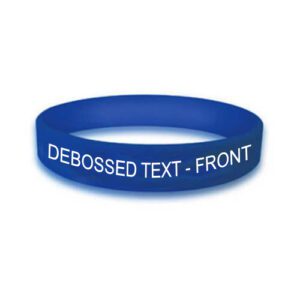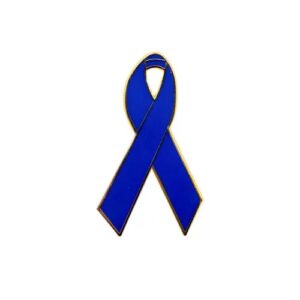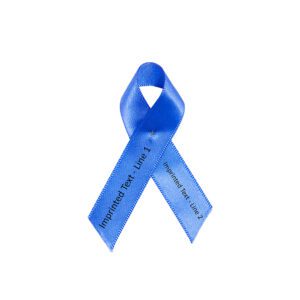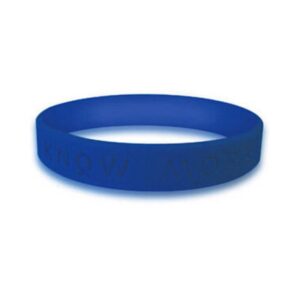Search by Color or Cause
$49.95
Wear your heart on your sleeve with a blue fabric awareness ribbon on your lapel.
Shop Personalized Cause for awareness ribbons, pins, and wristbands for over 1000 causes.
Our blue cloth fabric ribbons come in bags of 250 pieces (bulk).
Simple awareness ribbons started it all: a global movement for a better tomorrow. Today, an awareness ribbon is an iconic, worldwide symbol of hope for warriors and survivors, alike. For over twenty years, Personalized Cause has been at the forefront of the awareness ribbon movement, and strives to keep abreast of ever-changing awareness color and cause updates. Through this attention to cause awareness, Personalized Cause raises hope, encourages compassion, and highlights medical, social, mental health, autoimmune, and cancer causes. These causes are near and dear to many. Pin a ribbon to your lapel to show support for cancer research fundraisers or group marches for social change,
Personalized Cause has the most up-to-date and comprehensive awareness cause and color reference guide on the internet. Because of that, it has taken years to compile a list that is accurate and inclusive. You can find this extensive cause list under Awareness Ribbons Colors Causes and Meanings | Reference Guide. You can also use the Find Your Product search tool on the Home Page to find the product you’re looking for – search by color or cause.
Grosgrain ribbons primarily contain cotton, polyester and fiber blends. Satin ribbons, on the other hand, primarily contain nylon or polyester. Grosgrain ribbons also have thick horizontal fibers, whereas satin ribbons are smooth to the touch. Satin ribbons are much softer than grosgrain ribbons. Many people love satin ribbons for their beautiful shiny finish, allowing them to create a sleek look.
Double-faced satin ribbon is perhaps the most common type of satin ribbon available. Like the name suggests, this ribbon has two right sides. Therefore, it doesn’t matter what side faces upward or outward, as both of the sides look the same. The alternative is a single faced ribbon, which has a shiny outer side and a muted underside. Our satin ribbons are double-faced.
We offer these blue fabric awareness ribbons in bags of 250 pieces. Our ribbons are perfect for fundraising, awareness events, cancer races, awareness campaigns, support groups, school fundraisers, funerals, memorial gifts, and promotional products. Wearing awareness ribbons sends a subtle message that you support a cause. For example, it might mean you are raising awareness for a particular social cause. Another reason to wear a ribbon is to support a medical or mental health cause. Further, perhaps the ribbon represents a cause that personally connects to a cause affecting animals. Again, the ribbon sits on the left side of the chest or over the heart which is symbolic for a cause that is heartfelt.
Please note: We cannot personalize these ribbons. However, click here to see our personalized fabric ribbons in similar colors with an attached safety pin on the back of the fabric ribbon.
Blue Awareness Ribbons – Causes, Colors, Meanings and Months:
The primary cause associated with blue awareness ribbons is Arthritis.
Arthritis
According to the Global RA Network, as of 2021, more than 350 million people globally have arthritis. As a result, arthritis awareness ribbons are one of the most popular items on this website. Arthritis is the nation’s primary cause of disability.
Personalized Cause offers an in-depth list of arthritis causes in our footer link. Please see this arthritis cause link for more information about arthritis causes.
Another primary cause associated with blue awareness ribbons is Colon Cancer and Diseases of the Colon.
Colon Cancer
Cancer that begins in the colon is called colon cancer, and cancer that begins in the rectum is called rectal cancer. Cancer that affects either of these parts may also be called colorectal cancer.
Personalized Cause offers an in-depth list of cancer causes in our footer link. Please see this cancer cause link for more information about cancer causes.
Colon Cancer and Colon Disorder causes may include:
Colon Cancer
Colorectal Cancer
Familial Polyposis
Rectal Cancer
Short Bowel Syndrome
Lastly, another primary cause associated with blue awareness ribbons is Autoimmune Disorders.
Autoimmune Disorders
An autoimmune disorder occurs when the body’s immune system attacks and destroys healthy body tissue by mistake. There are more than 80 autoimmune disorders.
Personalized Cause offers an in-depth list of autoimmune causes in our footer link. Please see this autoimmune conditions and disorders link for more information about autoimmune conditions and disorders causes.
Autoimmune causes may include:
Alopecia Areata
Ankylosing Spondylitis
Dermatomyositis
Guillain Barre Syndrome
ME / CFIDS
Myositis
Polymyositis
Transverse Myelitis
Other Blue Awareness Ribbons Causes Include:
Acute Respiratory Distress Syndromes / ARDS
Apraxia
Bullying Prevention (alternate color: Orange)
Child Abuse Prevention
Childhood Grief
Chronic Fatigue Syndrome
Dystonia
Epstein Barr Virus
Erb’s Palsy
Free Speech
Gambling Addiction
Human Trafficking
Huntington’s Disease
Histiocytosis
Ichthyosis
Leukodystrophies
Lip and Oral Cavity Cancer (alternate color: Red and White Pinstripes)
Mesothelioma
Mouth Cancer
Reye’s Syndrome
Stevens Johnson Syndrome
Teens Against Smoking
Victims’ Rights
Water Accidents
Water Quality
Awareness Months for Blue Causes
ARDS Awareness Month – October
Alopecia Awareness Month – September
Ankylosing Spondylitis Awareness Month – April
Apraxia Awareness Month – May
Arthritis Awareness Month – May
Child Abuse Prevention Month – April
Chronic Fatigue Syndrome Awareness Month – March
Colon Cancer Awareness Month – March
Colorectal Cancer Awareness Month – March
Crime Victims’ Rights Awareness Month – April
Drowning Awareness Month – August
Dysautonomia Awareness Month – October
Dystonia Awareness Month – September
Epstein-Barr Virus Awareness Month – September
Erb’s Palsy Awareness Month – October
Familial Polyposis Awareness Month – March
Free Speech Awareness Month – October
Gambling Addiction Awareness Month – March
Guillain Barre Syndrome Awareness Month – May
Human Trafficking Awareness Month – January
Huntington’s Disease Awareness Month – May
Hurricane Awareness Month – May
Histiocytosis Awareness Month – September
Ichthyosis Awareness Month – May
Interstitial Cystitis Awareness Month – October
Langerhans Cell Histiocytosis Awareness Month – September
Leukodystrophies Awareness Month – September
Lip and Oral Cavity Cancer – April
ME / CFIDS Awareness Month – May
Mesothelioma Awareness Day – September 26
Mesothelioma Awareness Month – September
Mouth Cancer Awareness Month – April
Myositis Awareness Month – May
Rectal Cancer Awareness Month – March
Reye’s Syndrome Awareness Month – September
Short Bowel Syndrome Awareness Month – March
Steven Johnson Syndrome Awareness Month – August
Transverse Myelitis Awareness Month – June
Victims’ Rights Awareness Month – October
Water Quality Awareness Month – August
Water Safety Awareness Month – May
WHAT IS THE HISTORY OF THE AWARENESS RIBBON?
In 1979, Penney Laingen’s husband was held prisoner during the Iran hostage crisis. To call attention to this, she placed yellow ribbons on trees in her neighborhood. She also created yellow ribbons for people to wear to show support for her husband and others being held hostage. This was the first time an awareness ribbon was used publicly as a way to silently voice support.
About ten years later, the group Visual AIDS used a bright red ribbon to represent awareness and support for AIDS and the lives lost to it. This trend caught on quickly. Awareness ribbons were so well accepted as a way to demonstrate support, in fact, that the New York Times declared 1992 as The Year of the Ribbon.
That was the same year the pink ribbon became associated with breast cancer. The Susan G. Komen Breast Cancer Foundation (now Susan G. Komen for the Cure) handed out pink hats to breast cancer survivors who participated in their Race for the Cure. Soon after, in 1992, Komen distributed pink ribbons to everyone who participated in the race.
The next big step came later that year. Alexandra Penney, editor of Self Magazine, produced their second annual Breast Cancer Awareness Month issue. This issue was inspired by Evelyn Lauder, Vice President of Estee Lauder. She was also a breast cancer survivor. Alexandra and Evelyn collaborated to create a pink ribbon to distribute in cosmetic stores throughout New York City. This action was so popular that eventually the pink ribbons were placed on cosmetics counters all across the United States during Breast Cancer Awareness Month.
That year, 1.5 million ribbons were distributed. On each one was a card that explained how to do self breast exams. They also collected over 200,000 petitions, asking the White House to provide additional funding for breast cancer research.
The next year, in 1993, popularity grew. Avon joined in the fight for breast cancer awareness and launched a pink rhinestone brooch in the shape of the pink awareness ribbon. In two years, sales from the pin raised over $10 million for breast cancer research. This visibility helped make everyone more aware of the need for research.
Many people believe that because of these awareness ribbons and the visibility they created, federal funding for breast cancer research increased from approximately $100 million in 1991 to over $550 million in 1996. This helped pave the way for pink ribbons and other colors, calling attention to the need for research money for causes such as autism, epilepsy, Alzheimer’s and many more.
Calling attention to various diseases and disorders, as well as social causes, is the impetuous behind awareness ribbons. Showing support and understanding can often make all the difference to those who struggle.



